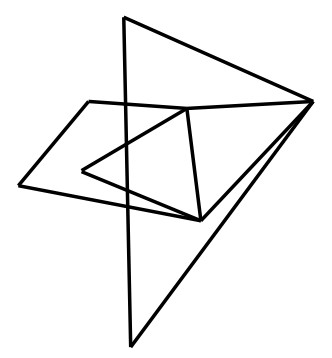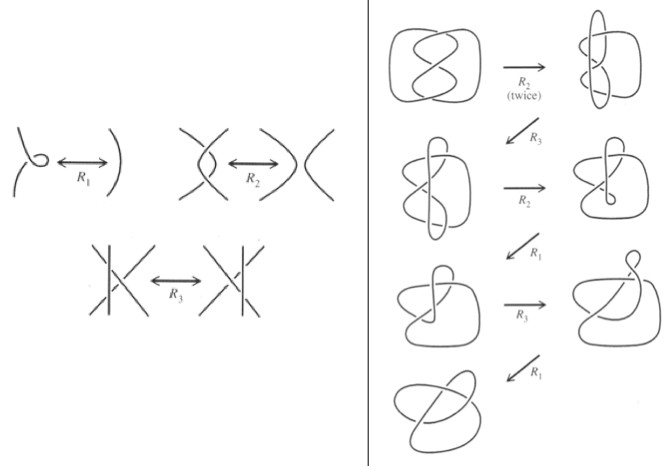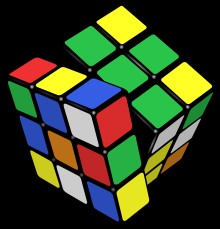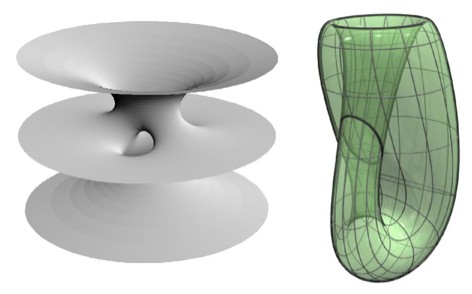The original question was:
How does a scientist/physicist map ideas and concepts into/onto mathematics? Are there a sequence of steps? If one starts with a mathematical model I can sort of see how using deduction, induction etc….
And what about the case where there is no mathematical model? How does ideas concepts get from mind to math/formulas? What is the “dirty work” that goes on behind the scenes?
Physicist: It’s hard to imagine most of the goings on in the world being turned into math. Generally when “math” is brought up, most of us think of arithmetic, which really doesn’t do a whole lot on its own. The majority of the interesting stuff in the world involves stuff much more fancy. There’s already a lot of mathematical structures out there (calculus and topology and all kinds of stuff) so, when you can, you find one that’s familiar and see if it fits. Otherwise you just create new maths.
Here’s how it starts: you tinker about with something until you notice a pattern. Then you make up symbols that allow you to write down those patterns. Then you see what the repercussions are.
For example: “***”, “ggg”, and “@@@”, all have something in common. So, make up a symbol: “3”. Make up some more symbols for other similar patterns and you’ve got the natural numbers: 1, 2, 3, 4, …
Now you can start making up symbols to describe all the reasonable things you can do with numbers: ““. Boom! Now you’re cooking with arithmetic!

2+3=5. Any questions you may have about the properties of "+" should be directed to the appropriate diagram.
Here’s where the abstraction starts. New symbols come as part of a package that includes rules. Generally by staring at the situation you can pull the rules out. For example, by looking at the picture above you’ll notice that it doesn’t matter which group on the left side is first, so: 2+3=3+2. Holy crap! Commutativity!
Now you can start poking the rules to see how far they bend. If they bend too far, you may find yourself in need of new symbols and rules. For example: What happens if you subtract a larger number from a smaller number? What if you add three or more numbers together instead of just two? Keep up this line of questions and pretty soon you get parentheses, primes, rational numbers, all kinds of stuff.
As often as not, new ideas, symbols, and rules are created because they are needed, as opposed to being found (like the picture above). For example: you can get from the natural numbers (1,2,3,..) to the rational numbers (2/3, 17/5, …) by merely asking some very reasonable questions about division. But the rational numbers have “gaps” (like and
). So now you need a number system with no gaps. What do you do? Make it up! Call it the “real numbers”,
.
What’s surprising, from a philosophical point of view, is that the rules that apply in one place apply in others. Which is really nice, because then the rules and symbols that have been found in one area can immediately be applied in another.
Calculus, which only works on continuous things (like the real numbers), applies very well to describing fluid flow, despite the fact that fluids aren’t continuous (they’re made of atoms). Even weirder; most quantum mechanical systems share a lot of properties in common with complex numbers. So as QM was first being fleshed out it already had a couple hundred years of complex analysis to build on.
Don’t be deceived by the notion that the field of mathematics is dominated by numbers. Keeping with the idea of 1) find a pattern, 2) make up a symbol and some rules, and 3) run with it: here are some other fields of math that have very little to do with numbers.
Geometry: That’s right, geometry. It doesn’t really need numbers, it’s just taught that way. You start with “two points make a line” and out pops about a thousand years of Greek history.
Algebra (group theory): This is the entirely abstract study of “there’s stuff, and things can happen to that stuff”.
To be more rigorous, and to actually get stuff done, it primarily considers “groups“, which have more structure than just “there’s stuff”.
Graph theory: The study of dots, and the lines that connect them. If you’ve spent any time doodling, there’s a good chance you accidentally did some graph theory. One simple result is: Any graph where every “vertex” has an even number of “edges” connected to it can be drawn completely without ever picking up your pen or repeating a line.

Starting anywhere on this graph you can draw the whole thing without lifting your pen, or repeating lines, because every vertex connects to an even number of edges.
This theorem is just another example of what happens when you start writing down patterns and rules, and following where they lead.
Topology: You usually hear about this in the context of “coffee mugs and donuts”. This covers stuff like Mobius strips, and tori, to really weird stuff like projective planes. Try this: take two Mobius strips and glue their edges to each other. If you did it right you should have a Klein bottle. Also, you can’t do it right because we don’t live in 4 or more dimensions. Another result from the wide and weird world of algebraic topology!
Logic: This includes stuff like: “If P, then Q” is equivalent to “If not Q, then not P”. Surprisingly useful stuff, and it started with someone sitting down and making up rules and symbols (specifically: George Boole). By the way, he would have written this last statement, ““.
Knot theory: Knot logic is logic nonetheless (suck on that, logicians!). This is seriously alien math that takes the frustration of tangled string, and kicks it up a notch. Knot theory also borrows some of the machinery from polynomials (despite having nothing to do with polynomials themselves) to form the various forms of knot polynomials.

The "Reidemeister Moves" from knot theory are an example of what passes for algebra over there. Ever twist or untwist a rubber band? Now it's got a name: R1.
So the point is: “turning something into math” just means writing down the patterns you see, and then pondering, for a while, the consequences of those patterns. If there’s no readily available notation or symbols, make something up. Let creativity be .
When “there’s no mathematical model” you either make one up, or you’re screwed. But the rules you come up with really need to be solid. For example, you could say “Let the quantity of love be L. Love grows with time, therefore ” (the time derivative of love is positive). But this isn’t a well defined quantity, nor is this a hard and fast rule (You taught me well, Becky!). You could create an entire mathematical system based on your lovsumptions (assumptions about love), but it won’t have anything to do with reality, or indeed love, if the rules aren’t solid.









Pingback: Linkblogging For 04/01/11 « Sci-Ence! Justice Leak!
I love this question and I think this is a question that any science/math classes at any level of education should attempt to answer, though rarely openly stated in curriculums.
I’ve never seen a description of doing it in a concrete sequence of steps, but I imagine even if there is such a sequence, it’d be quite general (vague).
So one would have to learn this art form by examples, which is why frequently in a book or lecture, before a definition/concept/theorem is given there’s a discussion on the general intuition.
Or perhaps after the definition/concept is given, one makes some attempt at saying why such a thing makes sense (and do some “dirty work” of verifying that it makes sense), what was the first guy who made this definition thinking and doing at the time, and how you might come up with it or an alternative to it.
…Though, in the case where mathematic models already exist, it isn’t really a process of “mapping” an idea to the math, but simply “recognizing” the idea to be describable by that model, given that one has honest to god understanding and familiarity with the model, not just having memorized the symbols and formulas.
IMO/YMMV etc.
I think it was Euler who came up with the ideas of “vertex” and “edge”. Before him people only saw doodles, after him, everyone saw graphs.
So, in the sense, everyone can formulate their own maths? That’s great. It’s as if we are all mathematicians. Maybe that’s the reason why people can develop different routines because patterns always exist everywhere even if we don’t recognize them.
So I can conclude that the reason why we humans exist is because we can build different maths. Primitive man needs nothing more but the brain to start a fire. And from the discovery of fire, more complex maths pop out of existence. So when you run back the time line, you will find out that humans were really born mathematicians.
It inspired me when I first saw this page. It’s as if I’m free to do what I want to do because I can express everything. And that everything could be in terms of mathematical language.
Absolutely! Everyone can definitely create their own maths no problem. However, there are two dangers: reinventing the wheel, and lack of rigor.
Most mathematicians (maybe all scientists, maybe everyone) go through a phase where they start figuring stuff out on their own, and become convinced that they’ve found new discoveries. Unfortunately, that’s very rarely the case. There are a lot of other people out there faced with the same puzzles and problems, who are also thinking very hard.
How do you create a mathematical formula in a science experiment?
This is such an interesting topic. Is there any book that I can look into about this subject?? Or any other articles or websites?? I would greatly appreciate it!
Question- Which statement is more accurate? Issac Newton invented calculus- or – Issac Newton discovered calculus
I think you’d have to askamathmatician.lol
A mathematician who recently derived the theoretical relation between circumference to it’s diameter of any circle (commonly known as PI). Which is not discovered by any body of this world so far. And also invent many forms of mathematics which are nobody knows.
Most molecules are predominantly in singlet ground state.Although triplet state is lower in energy why molecules prefer to be in singlet state.Nature would prefer an arrangement which give lower energy. Why this is so?
You state, “Geometry does not need numbers, it’s just taught that way.’In the mid ,50’s, I was taught plane geometry in high school. Our te4acher restricted us to a ruler and a straight edge. We sure didn’t utilize any numbers. Maybe in more recent times numbers are used in the teaching of geometry, but not then.
More fkced up are chems formulas liquid into math with some concentration fluids…